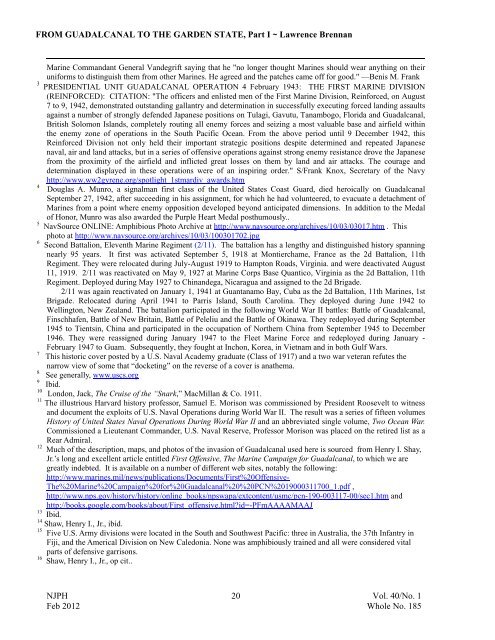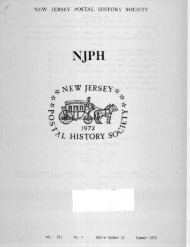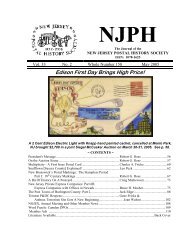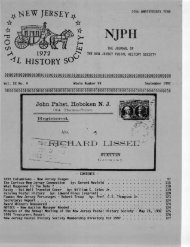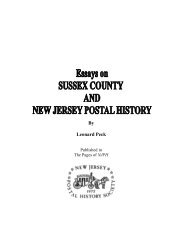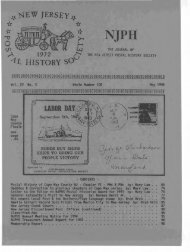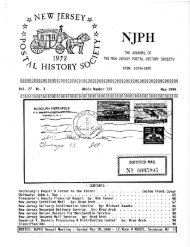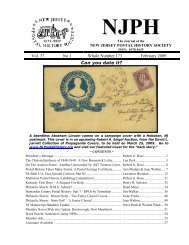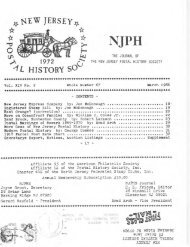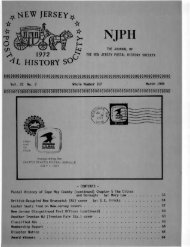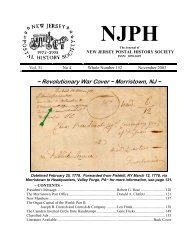185 - New Jersey Postal History Society
185 - New Jersey Postal History Society
185 - New Jersey Postal History Society
You also want an ePaper? Increase the reach of your titles
YUMPU automatically turns print PDFs into web optimized ePapers that Google loves.
FROM GUADALCANAL TO THE GARDEN STATE, Part I ~ Lawrence Brennan<br />
Marine Commandant General Vandegrift saying that he "no longer thought Marines should wear anything on their<br />
uniforms to distinguish them from other Marines. He agreed and the patches came off for good." —Benis M. Frank<br />
3 PRESIDENTIAL UNIT GUADALCANAL OPERATION 4 February 1943: THE FIRST MARINE DIVISION<br />
(REINFORCED): CITATION: "The officers and enlisted men of the First Marine Division, Reinforced, on August<br />
7 to 9, 1942, demonstrated outstanding gallantry and determination in successfully executing forced landing assaults<br />
against a number of strongly defended Japanese positions on Tulagi, Gavutu, Tanambogo, Florida and Guadalcanal,<br />
British Solomon Islands, completely routing all enemy forces and seizing a most valuable base and airfield within<br />
the enemy zone of operations in the South Pacific Ocean. From the above period until 9 December 1942, this<br />
Reinforced Division not only held their important strategic positions despite determined and repeated Japanese<br />
naval, air and land attacks, but in a series of offensive operations against strong enemy resistance drove the Japanese<br />
from the proximity of the airfield and inflicted great losses on them by land and air attacks. The courage and<br />
determination displayed in these operations were of an inspiring order." S/Frank Knox, Secretary of the Navy<br />
http://www.ww2gyrene.org/spotlight_1stmardiv_awards.htm<br />
4<br />
Douglas A. Munro, a signalman first class of the United States Coast Guard, died heroically on Guadalcanal<br />
September 27, 1942, after succeeding in his assignment, for which he had volunteered, to evacuate a detachment of<br />
Marines from a point where enemy opposition developed beyond anticipated dimensions. In addition to the Medal<br />
of Honor, Munro was also awarded the Purple Heart Medal posthumously..<br />
5 NavSource ONLINE: Amphibious Photo Archive at http://www.navsource.org/archives/10/03/03017.htm . This<br />
photo at http://www.navsource.org/archives/10/03/100301702.jpg<br />
6 Second Battalion, Eleventh Marine Regiment (2/11). The battalion has a lengthy and distinguished history spanning<br />
nearly 95 years. It first was activated September 5, 1918 at Montierchame, France as the 2d Battalion, 11th<br />
Regiment. They were relocated during July-August 1919 to Hampton Roads, Virginia. and were deactivated August<br />
11, 1919. 2/11 was reactivated on May 9, 1927 at Marine Corps Base Quantico, Virginia as the 2d Battalion, 11th<br />
Regiment. Deployed during May 1927 to Chinandega, Nicaragua and assigned to the 2d Brigade.<br />
2/11 was again reactivated on January 1, 1941 at Guantanamo Bay, Cuba as the 2d Battalion, 11th Marines, 1st<br />
Brigade. Relocated during April 1941 to Parris Island, South Carolina. They deployed during June 1942 to<br />
Wellington, <strong>New</strong> Zealand. The battalion participated in the following World War II battles: Battle of Guadalcanal,<br />
Finschhafen, Battle of <strong>New</strong> Britain, Battle of Peleliu and the Battle of Okinawa. They redeployed during September<br />
1945 to Tientsin, China and participated in the occupation of Northern China from September 1945 to December<br />
1946. They were reassigned during January 1947 to the Fleet Marine Force and redeployed during January -<br />
February 1947 to Guam. Subsequently, they fought at Inchon, Korea, in Vietnam and in both Gulf Wars.<br />
7<br />
This historic cover posted by a U.S. Naval Academy graduate (Class of 1917) and a two war veteran refutes the<br />
narrow view of some that “docketing” on the reverse of a cover is anathema.<br />
8<br />
See generally, www.uscs.org<br />
9<br />
Ibid.<br />
10<br />
London, Jack, The Cruise of the “Snark,” MacMillan & Co. 1911.<br />
11 The illustrious Harvard history professor, Samuel E. Morison was commissioned by President Roosevelt to witness<br />
and document the exploits of U.S. Naval Operations during World War II. The result was a series of fifteen volumes<br />
<strong>History</strong> of United States Naval Operations During World War II and an abbreviated single volume, Two Ocean War.<br />
Commissioned a Lieutenant Commander, U.S. Naval Reserve, Professor Morison was placed on the retired list as a<br />
Rear Admiral.<br />
12 Much of the description, maps, and photos of the invasion of Guadalcanal used here is sourced from Henry I. Shay,<br />
Jr.’s long and excellent article entitled First Offensive, The Marine Campaign for Guadalcanal, to which we are<br />
greatly indebted. It is available on a number of different web sites, notably the following:<br />
http://www.marines.mil/news/publications/Documents/First%20Offensive-<br />
The%20Marine%20Campaign%20for%20Guadalcanal%20%20PCN%2019000311700_1.pdf ,<br />
http://www.nps.gov/history/history/online_books/npswapa/extcontent/usmc/pcn-190-003117-00/sec1.htm and<br />
http://books.google.com/books/about/First_offensive.html?id=-PFmAAAAMAAJ<br />
13 Ibid.<br />
14 Shaw, Henry I., Jr., ibid.<br />
15 Five U.S. Army divisions were located in the South and Southwest Pacific: three in Australia, the 37th Infantry in<br />
Fiji, and the Americal Division on <strong>New</strong> Caledonia. None was amphibiously trained and all were considered vital<br />
parts of defensive garrisons.<br />
16 Shaw, Henry I., Jr., op cit..<br />
NJPH 20<br />
Vol. 40/No. 1<br />
Feb 2012 Whole No. <strong>185</strong>


